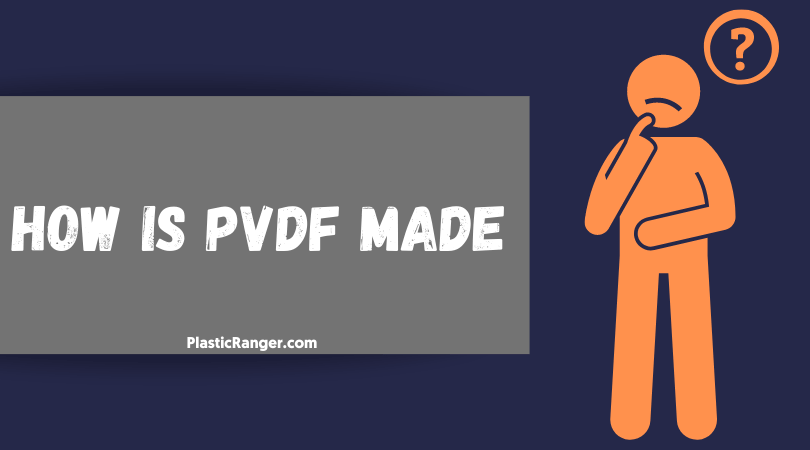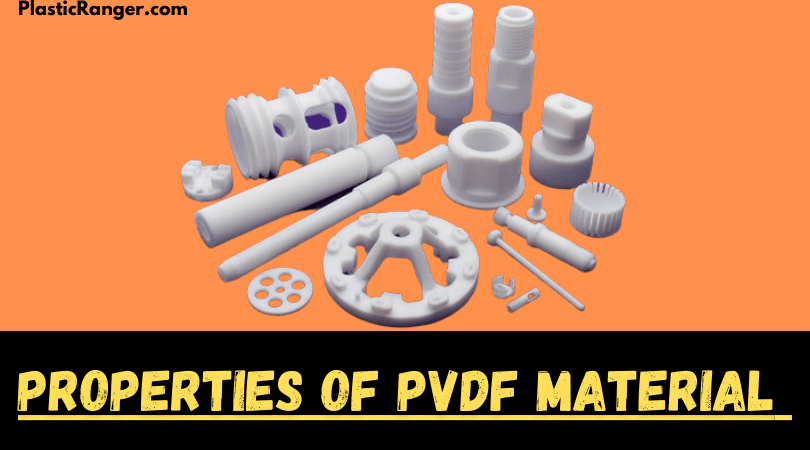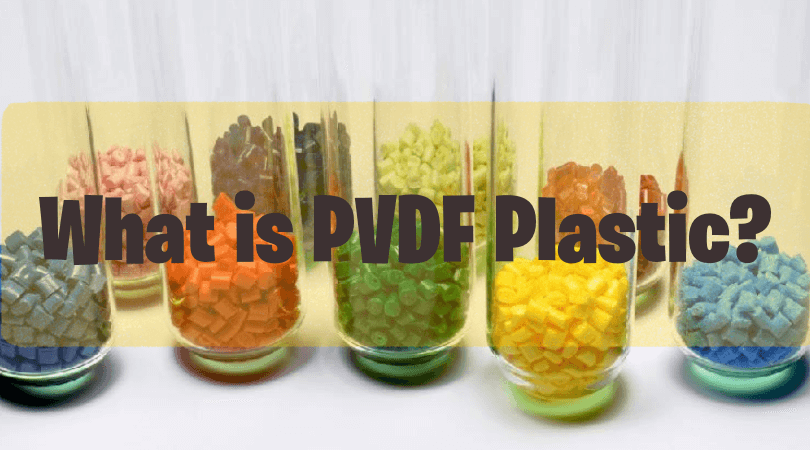Hello, you amazing people, today I will be sharing a phenomenal piece of an article on a semi-crystalline plastic with applicability on par with a lot of mainstream plastic materials.
What is PVDF (Polyvinylidene Fluoride)?
PVDF or Polyvinylidene Fluoride is a semi-crystalline structured, highly inert, tough, and stable thermoplastic fluoropolymer. It has a melting point of 175°C and service temperatures up to 150°C.
It boasts overall great properties like excellent chemical resistance, high crystallinity, decent compressive strength and good thermal stability, to name a few.
It is one of the best radiation-resistance plastics available in the market, only bested by PEEK and Polyamide.
The set of excellent properties makes PVDF a prime choice for healthcare and construction sector applications
Today it is sold under various brand names with added additives and melt flow rates to increase the processing capabilities and heighten properties for specific applications.
How is PVDF Made?

PVDF resin is produced by free-radical polymerization of 1,1-difluoroethylene (CH2=CF2). The polymerization occurs in the emulsion of the 10-150°C and 10-300 atm pressure. The obtained material is then processed into films, rods, tubes, and sheets.
The most common methods to produce PVDF polymer are – Chlorotrifluoroethylene (CTFE) or hexafluoropropylene (HFP).
HFP-made PVDF copolymer shows higher flexibility compared to PVDF homopolymer grades.
Comoolymes made by CTFE are even superior to polymers made by HFP. They are more flexible, have low shrinkage, and have a fantastic low-temperature performance range.
Furthermore, Polyvinylidene Fluoride is exposed to ionizing radiation using crosslinking, making various modifications to the thermal and mechanical properties possible.
Additionally, different resins like acrylics methacrylic, and acrylic rubbers have partial compatibility with the polymer.
Properties of PVDF Material

Let’s discuss the general properties of PVDF polymer in detail:

Source: Royal Society of Chemistry
| Properties | Values | Units |
| Processing Temprature | -220°C | – |
| Tensile Strength @23°C | 50 | Mpa – ASTM – D638 |
| Thermal Conductivity@23°C | 0.2 | W/m.k – ASTM C177 |
| Impact Strength | No Break | – |
| Melting Point | 338-347 | deg F |
| Dielectric Strength | 20-25@ 1mm thick | kV.mm – ASTM D149 |
| Elongation at Break @23°C | 0.4 | ASTM-D1894 |
| Continues working temperature | 150 | °C |
| Weathering resistance | Excellent | – |
| Coefficient of friction | 0.4 | ASTM-D1894 |
| Limiting Oxygen Index | 44 | % |
Crystal Structure of PVDF
As I mentioned earlier, it has a semi-crystalline polymer that is 50% amorphous. The structure is formed so that most VDF units are linked together from head to tail, and many teams are linked head to head.
The fluoropolymer exists in four conformations – α, β, γ, and δ shape.
The C-F bonds are opposite, creating an alignment to obtain the highest dipole movement in the same direction. The β phase is the prudent phase for the piezoelectric characteristics of the resin.
The opposite direction of the dipole movement to crystallites results in zero net polarization.
Mechanical Properties
Talking about mechanical properties, PVDF has a good tensile modulus but fairs weak in the impact strength department. Rearrangements using HFP and CTFE can help improve the flexibility and impact strength and decrease the tensile modulus.
PVDF is non-flammable and wouldn’t drip. It is self-extinguishing and has decent resistance to UV light.
Physical Properties
Talking about the physical properties, The polymer has one of the highest heat deflection temperatures under load(148°C @0.5Mpa) among commercial fluoropolymers and the lowest melting point(178°C).
Thanks to high crystallinity and surface tension properties, PVDF polymers have meager imbuing values than other fluoroplastics.
The same imbuing effects can be seen with gases and liquids as well. Having said that, the imbuing capability depends entirely on the crystalline modification of parts.
Chemical Resistance
All fluoropolymers (including PVDF) contain varying chemical inoperativeness to various chemicals.
The polymer is blended with organic solvents like animes and esters at high temperatures, making them capable enough to be applied as corrosion resistance glazing of chemical processing equipment.
PVDF partially exhibits excellent resistance to organic acids, aliphatic and aromatic hydrocarbons, alcohols, and halogenated solvents. However, it can also be readily attacked by strong bases and ketones.
Electrical Properties
PVDF material possesses high dielectric strength and dissolution factor. However, it also suffers from poor electrical properties, which helps the polymer be easily utilized in films with piezoelectric behavior.
These films are extracted from B-phase conformation. Both the films’ surfaces will be glittered and put through high voltage, leaving them permanently polarized.
These films produce current when stretched or compressed at their melting point temperature.
Disadvantages of Polyvinylidene Fluoride

We have gone through the sweeter part of the popular fluoropolymer, but let’s dive into a few limitations or drawbacks one might face using PVDF plastic or resin.
- Processing machinery needs to be clean and tidy for optimum results
- Poor resistance to fuming acids
- High dissipation factor
- Decomposition by boron makes it difficult for the polymer to reinforce with glass fibers.
How to Process PVDF?

PVDF material is available in various grades and forms, like powders and pallets. It can be easily processed by traditional methods like Injection molding, extrusion, compression, and transfer molding.
Drying isn’t essential but might be required in some operations.
The constant processing temperature – 190 to 280°C
Let’s see a comparison between injection molding and extrusion process attributes.
| Injection Molding | Extrusion |
| Melt Temprature – 200°C to 270°C | Attention must be given to removing dead spots, or it can lead to the creation of degradation. |
| Advisable mold temprature is 50°C to 90°C | Reemmded extrduion temprature – 230°C to 290°C |
| PVDF’s higher melt viscosity becomes an important factor to keep the mold design accurate | extrusion of PVDF doesn’t require additional aids, lubricants, and heat stabilizers |
| Shrinkage – 3 to 4% | Rececemneod L/D ration – 20 |
| Applications – Valves, filter plates, pipelines, coil bodies, fittings, etc. | Applications – Pipes, tubes, heat-shrinkable tubings, etc. |
PVDF Applications
- It has various electrical and electronics industry applications, ranging from wires and cables in aircraft, high-temperature wirings, home appliances, wire coatings, and industrial power control systems.
- Good corrosion properties, by taking the help of some additives, can improve its applicability to heavy industries like oil & gas, automotive, marine, and petrochemicals for gaskets, seals, linings, etc.
- It is lately utilized heavily in filtration equipment like housings, filters, membranes, etc.
- Polyvinylidene Fluoride is also used for making separators in lithium-ion batteries thanks to reliable thermal and chemical stability. These membranes are in demand as the market for electric mobility will see sizable growth.
- Chemical processing equipment depends on PVDF resin to make flexible tubing and liners for water systems, chemical pipes, automobile fuel lines, and storage.
- Piezoelectric films are very sensitive transducers. They are malleable, rigid, and lightweight; thus can be shaped into various geometries resulting in unique and innovative applications.
- It is also used for coating and layering applications on metals like aluminum and galvanized steel to improve their chemical resistance and weatherability.
Engaging Read – Which is the Best Acrylic Glue? | The Best Plexiglass Glue
The Future of PVDF
According to a study conducted by MarketWatch, the global Polyvinylidene Fluoride was valued at USD 535.4 million in 2019 and is pegged to reach a value of USD 1567.5 million by the end of 2026, showing a CAGR of 16.4%, which is very impressive.
Sure, the numbers have changed drastically because of the Covid-19 pandemic, and saying anything about the short-term growth outlook for PVDF is very difficult.
However, on the bright side, when writing this post, a vaccine has been created, people have started to come out and go to work, and the world is steadily opening up.
The Asia-pacific region is the largest producer of Polyvinylidene Fluoride( thanks to China) and will keep the leading position shortly too (again, thanks to China :))
As the above chart shows, pipes & fittings, Li-ion batteries, and semiconductor processing take a major chunk of the market and is expected to grow even further in the future due to growth in the electronics and electrical mobility sectors.
FAQs
Below are the frequently asked questions on PVDF material. Let’s dig deep to know more.
What is the difference between PVC and PVDF?
PVDF and PVC have many differences, the biggest being the working temperatures – PVDF works best at 284°F, and PVC works best at 140°F. PVFD also has more mechanical durability than PVC and is more resistant to chemicals and permeation.
Is PVDF a piezoelectric?
PVDF becomes an efficient ferroelectric polymer when polled, showing fantastic piezoelectric and pyroelectric properties. These attributes make PVDF a prime choice for sensor and battery applications.
Is PVDF acid resistant?
PVDF exhibits excellent chemical and cd resistant properties. It can withstand a variety of aggressive fluids and solvents. It mainly shows impressive physical resistance toward organic and inorganic acids, halogenated solvents, and hydrocarbons.
What is the difference between PVDF and powder coating on metal?
PVDF metal coating is a resin-based liquid coating system. On the other hand, powder coating is an electrostatic process in which the electrostatically charged powder is sprayed on the metal surface. Both coating options are good, but PVDF coating has more durability than powder coating.
What is the difference between PVDF and PTFE?
The main difference between PVDF and PTFE is that PTFE membranes can be used in aggressive filtration solutions and strong acids. However, PVDF membranes work very well to filtrate non-aggressive aqueous and mild organic solutions.
Suggested Read –
- Plastics Vs. Polymers | What are the Differences?
- What is Polypropylene Material?
- What is PETG Material? | The Definitive Guide
- When Was Plastic Invented? | The History of Plastics
- LDPE VS HDPE: What are the Differences and Similarities
- 7 Types of Plastics | An Helpful Illustrated Guide
- What is Polyethylene?
- What is Warpage? | Causes of Warpage | Warpage Variations
Final Thoughts
PVDF plastic is a material that offers versatility and durability with a plethora of advantageous properties. Its molecular structure is unique, featuring a chain of alternating carbon and fluorine atoms that give it excellent resistance to UV radiation, heat, and chemicals. This feature makes it perfect for different applications, ranging from medical devices to aerospace and construction.
However, the production and disposal of PVDF can have an unfavorable environmental impact, driving the quest for more sustainable options. Nonetheless, the benefits of PVDF make it a valuable material in various industries, making it an excellent choice for multiple applications.
Thank you very much.
Quick Navigation


